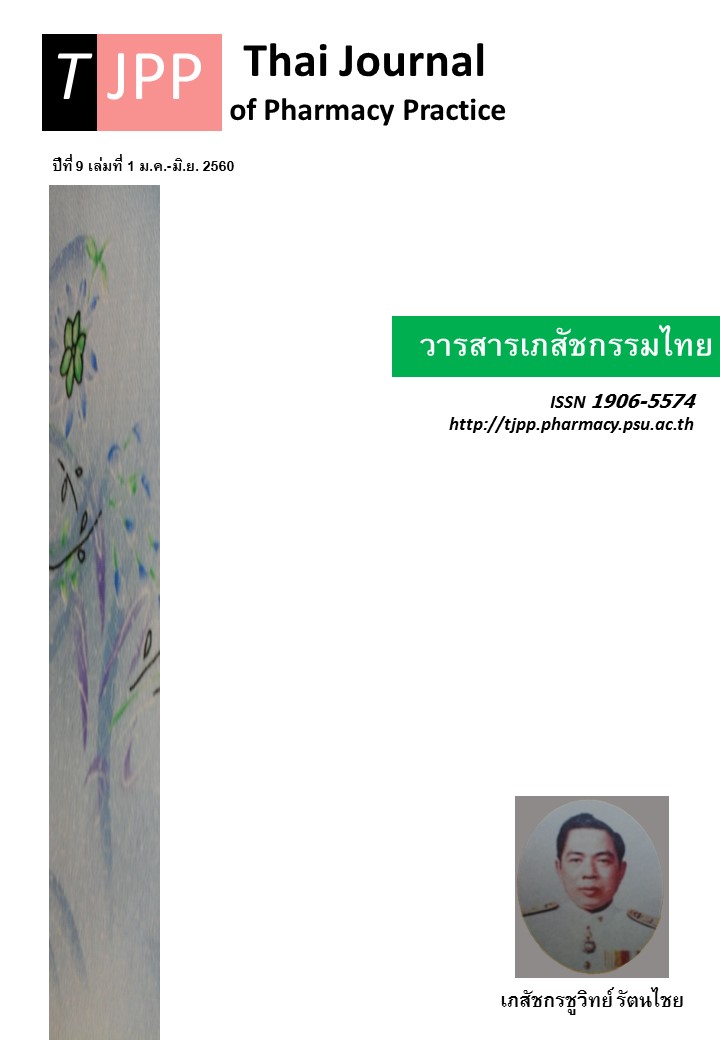ความสามารถในการใช้ฉลากโภชนาการของผู้บริโภคใน 5 จังหวัดภาคใต้: พัทลุง สตูล ปัตตานี ตรัง และสงขลา
Main Article Content
บทคัดย่อ
วัตถุประสงค์: เพื่อสำรวจความสามารถในการใช้ฉลากโภชนาการของผู้ป่วยโรคเรื้อรัง นักศึกษาระดับประกาศนียบัตรวิชาชีพชั้นต้นในปีที่ 3 (ปวช. 3) นักเรียนชั้นมัธยมศึกษาปีที่ 6 (ม. 6) และกลุ่มแม่บ้านหรือพ่อบ้านใน 5 จังหวัดภาคใต้ (พัทลุง สตูล ปัตตานี ตรัง และสงขลา) วิธีการ: การสำรวจทำในตัวอย่าง 4,076 คนซึ่งอาศัยอยู่ใน 5 จังหวัดภาคใต้ จำแนกเป็นผู้ป่วยโรคเรื้อรัง 970 รายที่เป็นผู้ป่วยนอกในสถานพยาบาลระดับต่าง ๆ 17 แห่งที่เลือกมาแบบตามสะดวก นักศึกษาระดับปวช. 3 จำนวน 829 คนในสถานศึกษา 13 แห่งที่เลือกมาแบบสุ่มอย่างง่าย นักเรียน ม. 6 จำนวน 1,160 รายใน 22 โรงเรียนที่เลือกมาด้วยวิธีการสุ่มอย่างง่าย และแม่บ้านหรือพ่อบ้าน 1,117 รายจาก 19 หมู่บ้านหรือชุมชนที่เลือกมาอย่างสุ่มจากหมู่บ้านในจังหวัดตรัง พัทลุง สงขลา และสตูล รวมทั้งผู้ที่อาศัยในจังหวัดปัตตานี 200 รายที่มาจับจ่ายในศูนย์การค้าขนาดใหญ่แห่งหนึ่งในพื้นที่ การศึกษาเก็บข้อมูลโดยใช้แบบสอบถามชนิดตอบเอง 20 ข้อที่พัฒนาขึ้นในการวิจัยนี้เพื่อวัดความรู้เบื้องต้นเรื่องฉลากโภชนาการ ความรู้เรื่องสารอาหาร ความสามารถในการค้นหาข้อมูลบนฉลากโภชนาการ ความสามารถในการคำนวณ ความสามารถในการเปรียบเทียบผลิตภัณฑ์ 2 ชื่อการค้า และความสามารถในการเลือกผลิตภัณฑ์เมื่อมีสภาวะโรค ผลการวิจัย: ผู้ป่วยโรคเรื้อรังมีความสามารถในการใช้ฉลากโภชนาการน้อย โดยเฉพาะอย่างยิ่งความสามารถในการคำนวณโดยใช้ข้อมูลบนฉลากโภชนาการ (ค่าเฉลี่ย 0.32+0.37 จากคะแนนเต็มหนึ่ง) และการเลือกผลิตภัณฑ์เมื่อมีสภาวะโรค (ค่าเฉลี่ย 0.45+0.35) ส่วนความสามารถในการค้นหาข้อมูลบนฉลากและการเปรียบเทียบสารอาหาร มีค่าเฉลี่ย 0.57-0.58 ผลการวิจัยในกลุ่ม ม. 6 ปวช 3 และพ่อบ้านหรือแม่บ้านก็พบผลในลักษณะเดียวกัน คือ ความสามารถในการคำนวณรและความสามารถในการเลือกผลิตภัณฑ์เมื่อมีสภาวะโรคได้คะแนนน้อยกว่าความสามารถในการค้นหาข้อมูลบนฉลากและการเปรียบเทียบสารอาหารบนฉลาก ปัจจัยมีผลต่อความสามารถในการค้นหาข้อมูลที่เพิ่มขึ้น คือ เพศหญิง การศึกษา ความรู้เรื่องสารอาหารและฉลากโภชนาการ ปัจจัยที่มีผลต่อความสามารถที่ดีกว่าในการคำนวณ ความสามารถการเปรียบเทียบสารอาหารบนฉลากโภชนาการ และความสามารถในการเลือกผลิตภัณฑ์เมื่อมีสภาวะโรค คือ ความสามารถในการค้นหาข้อมูล ความรู้เบื้องต้นเรื่องฉลากโภชนาการ ความรู้เรื่องสารอาหาร และการศึกษาที่สูงกว่า สรุป: ผู้ป่วยโรคเรื้อรังยังมีความสามารถในการใช้ฉลากโภชนาการน้อย ความสามารถในการคำนวณและการเลือกผลิตภัณฑ์เมื่อมีสภาวะโรคเป็นทักษะที่ตัวอย่างทุกกลุ่มมีคะแนนน้อยกว่าทักษะอื่น ๆ ความรู้เบื้องต้นเกี่ยวกับฉลากโภชนาการ ความรู้เบื้องต้นเกี่ยวกับสารอาหาร และความสามารถในการค้นหาข้อมูลบนฉลากโภชนาการเป็นปัจจัยพื้นฐานที่มีความสำคัญต่อความสามารถในการใช้ฉลากโภชนาการ
Article Details
ผลการวิจัยและความคิดเห็นที่ปรากฏในบทความถือเป็นความคิดเห็นและอยู่ในความรับผิดชอบของผู้นิพนธ์ มิใช่ความเห็นหรือความรับผิดชอบของกองบรรณาธิการ หรือคณะเภสัชศาสตร์ มหาวิทยาลัยสงขลานครินทร์ ทั้งนี้ไม่รวมความผิดพลาดอันเกิดจากการพิมพ์ บทความที่ได้รับการเผยแพร่โดยวารสารเภสัชกรรมไทยถือเป็นสิทธิ์ของวารสารฯ
เอกสารอ้างอิง
2. Popkin BM, Adair LS, Ng SW. Global nutrition transition and the pandemic of obesity in develop- ing countries. Nutr Rev 2012; 70: 3-21.
3. Finucane MM, Stevens GA, Cowan MJ, Danaei G, Lin JK, Paciorek CJ, et al. National, regional, and global trends in body-mass index since 1980: systematic analysis of health examination surveys and epidemiological studies with 960 country-years and 91 million participants. Lancet 2011; 377: 557-67.
4. Nazmi A, Monteiro C. The nutrition transition: the same, but different. Public Health Nutr 2013; 16: 571-2.
5. Lachat C, Otchere S, Roberfroid D, Abdulai A, Seret FM, Milesevic J, et al. Diet and physical activity for the prevention of noncommunicable diseases in low- and middle-income countries: a systematic policy review. PLoS Med 2013; 10: e1001465.
6. Mandle J, Tugendhaft A, Michalow J, Hofman K. Nutrition labelสing: a review of research on consumer and industry response in the global South. Glob Health Action. 2015; 8:25912. doi: 10.3402/gha.v8.25912.
7. Public Health Ministerial Declaration No. 182 in 1998 on nutrition labels. Royal Gazette No. 115, Part 47D special (June 11, 1998).
8. Public Health Ministerial Declaration No. 219 in 2001 on nutrition labels (No. 2). Royal Gazette No. 118, Part 70D special (July 26, 2001).
9. Foo LL, Vijaya K, Sloan RA, Ling A. Obesity prevention and management: Singapore’s experience. Obes Rev 2013; 14: 106_13.
10. Cecchini M, Sassi F, Lauer JA, Lee YY, Guajardo-Baron V, Chisholm D. Chronic diseases: tackling of unhealthy diets, physical inactivity, and obesity: health effects and
cost-effectiveness. Lancet 2010; 376: 1775_84.
11. Kim WK, Kim J. A study on the consumer’s perception of front-of-pack nutrition labeling. Nutr Res Pract 2009; 3: 300_6.
12. Singla M. Usage and understanding of food and nutritional labels among Indian consumers. Brit Food J 2010; 112: 83_92.
13. De la Cruz-Go´ngora V, Villalpando S, Rodriguez-Oliveros G, Castillo-Garcı´a M, Mundo-Rosas V, Meneses-Navarro S. Use and understanding of the nutrition information panel of prepackaged foods in a sample of Mexican consumers. Salud Publica de Mexico 2012; 54: 15866.
14. Cannoosamy K, Pugo-Gunsam P, Jeewon R. Consumer knowledge and attitudes toward nutritional labels. J Nutr Educ Behav 2014; 46: 334-40.
15. Vijaykumar S, Lwin MO, Chao J, Au C. Deter- minants of food label use among supermarket shoppers: a Singaporean perspective. J Nutr Educ Behav 2013; 45: 204-12.
16. Gregori D, Ballali S, Vecchio MG, Luis Marcel VC, Jorge BC, Cecilia BP, et al. How to communicate nutritional information to people: the attitudes of Chile population
toward food. Open Obes J 2013; 5: 36_42.
17. Jacobs SA, de Beer H, Larney M. Adult consu- mers’ understanding and use of information on food labels: a study among consumers living in the Potchefstroom and Klerksdorp regions, South Africa. Public Health Nutr 2011; 14: 510_22.
18. Sukprasert B. Study on attitudes, knowledge, understanding and the use of nutrition labels among Bangkokian [master thesis]. Bangkok: Mahidol University; 1997.
19. Sakthaworn S. Knowledge and attitudes regarding nutritional labels of teachers in Chiang Mai provincial public schools [independent study]. Chiang Mai: Chiang Mai University; 2002.
20. Kongchum S. Perception about nutrition facts labelling of Chiang Mai university students [independent study]. Chiang Mai: Chiang Mai University; 2003.
21. Sukjan W. Knowledge of nutritional labels of graduate students, Faculty of Education, Chiang Mai University [independent study]. Chiang Mai: Chiang Mai University; 2003.
22. Phokhangjust W, Sarakshetrin A, Chantra R. Knowledge, attitude, and practice towards nutrition and nutrition labels of nursing students at Boromarajonani College of Nursing, SuratThani. Journal of the Royal Thai Army Nurses 2015; 16: 93-100.
23. Sutthaphakti C. Consumer attitudes toward nutrition labels in Mueang district, Chiang Mai province [independent study]. Chiang Mai: Chiang Mai University; 2006.
24. Naiyachit M. Knowledge and behaviors of nutrition label use of people in Bangkok metropolis [master thesis]. Bangkokl: Ramkhamhaeng University of Washington; 2004.
25. Phugsin P. The use of nutrition label among students at college level [independent study]. Chiang Mai: Chiang Mai University; 2006.
26. Chaiyawong S. Knowledge and attitudes regarding nutritional labels of Rotarians in Mueang district, Chiang Mai province [independent study]. Chiang Mai: Chiang Mai University; 2001.
27. Thongdung S. Perception of nutritional labels among teenagers in Mueang district, Mae Hong Sorn province [independent study]. Chiang Mai: Chiang Mai University; 2003.
28. Cleesuntorn A. Education in Thailand and the challenging issues [online]. 2016 [cited Jan 8, 2017]. Available from: www.en.moe.go.th/index.ph p?option=com_content&view=article&id=3660:education-in-thailand-and-the-challenging-ssues&catid= 23:article.
29. Parinyasiri T. 6th ILSI Seminar and workshop on nutrition labeling, claims and communication strategies for the consumer. Malaysia: 2010. Nutrition Labeling and claims in Thailand - Update.
30. Nielsen Consumer Research. A Nielsen report: Battle of the bulge & nutrition labels, healthy eating trends around the world. New York: 2012.


